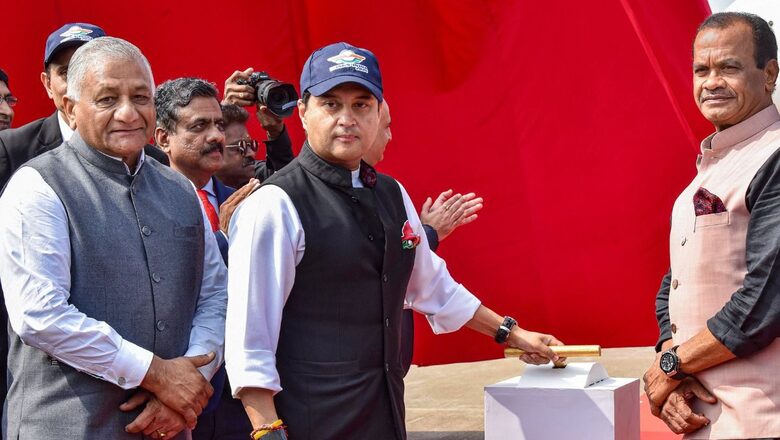
views
The biggest civil aviation event in Asia, Wings India 2024, began today, with minister Jyotiraditya Scindia inaugurating it at Begumpet airport in Hyderabad, Telangana.
The Union Ministry of Civil Aviation (MoCA), Airports Authority of India (AAI), and Federation of Indian Chamber of Commerce and Industry (FICCI) are coordinating the event, aligning with Prime Minister Narendra Modi’s vision to fulfil the common man’s aspirations of flying. The success of the previous edition has spurred the collaborative efforts for this one.
The four-day event comprises exhibitions, demonstration flights, static displays, media conferences, one-to-one business meetings, and more. Around 1,500 delegates from 106 countries and 5,000 business visitors are expected to attend the event. Additionally, there are expected to be 500 B2G/B2B meetings.
Aerospace engineers, airlines, airport agencies, airport operators, civil aviation authorities, policy makers, and government officials make up the delegate and visitor base. Special focus would be on the Global Ministerial Conference and Global CEOs’ Forum, with discussions on the industry’s future.
One of the biggest examples of India’s civil aviation industry’s ability to attract the biggest players for an investment would be the Boeing India Engineering & Technology Center (BIETC) campus at Aerospace Park in Devanahalli, near Kempegowda International Airport. Prime Minister Narendra Modi will inaugurate the new state-of-the-art centre on January 19.
Built with an investment of Rs 1,600 crore, the 43-acre campus is Boeing’s largest such investment outside the US.
Evolution of Wings India
The evolution of the Wings India event showcases the transformation of India’s aviation industry as a whole. The event that started as a dream to transform India’s regional connectivity in 2017, is now attracting biggest players, vying for a bite of India’s lucrative and rewarding aviation sector.
Wings India 2022 marked a transformative success that reshaped the aviation industry, showcasing technological advancements, potential collaborations, and visionary perspectives, serving as a platform for industry leaders to convene. The outcomes of Wings India 2022 had a profound impact on the trajectory of the aviation sector.
Following the event, the industry experienced a significant enhancement on sustainability, technology, and forthcoming trends. The global resonance of Wings India and analogous occurrences underscored the interdependence of the aviation sector.
This year, Wings India will signify a pivotal moment in civil aviation, contributing to the sector’s evolution for decades. The event showcases cutting-edge technologies, hosts insightful seminars, and connects global aviation enthusiasts, leaders, and innovators.
Hindustan Aeronautics Limited (HAL) is set to feature its indigenous civil platforms—the Hindustan-228 aircraft and the upgraded Advanced Light Helicopter (ALH) Dhruv civil helicopter—at the upcoming event.
Additionally, Boeing, the US aerospace giant, revealed on Friday that its new wide-body 777-9 jet will make its debut in India next week. The company stated that the latest addition to its leading wide-body family will actively participate in the event. The 777-9 flight test airplane is scheduled to land in Hyderabad on January 16 and will be on static display for Wings visitors from January 18-19, as announced by Boeing.
India’s Rising Aviation Industry
Surpassed only by the US and China, the Indian aviation sector holds the rank of the world’s third-largest domestic market. The Mumbai to Delhi route now stands as the third busiest globally. As of the financial year ending March 2023, the industry served approximately 200 million passengers, according to India’s Centre for Asia Pacific Aviation (CAPA). Currently, India boasts 140 operational airports, and the government aims to add another 200 in the next five years.
Driving this unprecedented growth is India’s aspirational middle class, experiencing rising incomes, coupled with deregulatory reforms that have unleashed entrepreneurial energies. Visionary policy actions aimed at inclusive development through universal air connectivity have also played a crucial role. The cumulative impact of these synergistic forces over the last decade has been revolutionary.
The industry underwent a significant shift from 2013-14 onwards, marked by reforms such as the removal of price caps, fostering competitive dynamics and more affordable flying options. Relaxations in ownership rules further empowered low-cost carriers such as IndiGo, SpiceJet, and GoAir to revolutionise the sector. These changes, coupled with the liberalisation of international operations and initiatives such as the UDAN regional connectivity scheme, propelled India’s civil aviation to become one of the fastest-growing sectors. Passenger traffic soared from 60 million in 2010 to an estimated 400 million by 2027.
Government Initiatives
In 2023, the government committed to spending Rs 980 billion ($11.88 billion) by 2025 to enhance regional connectivity through the construction of new airports and the modernisation of existing ones. The focus is on developing cutting-edge and sustainable airport infrastructure to accompany the expansion of the aviation sector.
Across the country, thousands of acres are being allocated for integrated Maintenance, Repair, and Overhaul (MRO) clusters, aiming to locally service over 500 planes by 2040. Greenfield projects like Jewar and Navi Mumbai international airports are underway to alleviate congestion in Delhi and Mumbai, fostering industrial development in their surrounding areas.
Major airports are investing in additional runways and expanding terminals, aiming to quadruple capacities by 2030 to handle over 100 flight movements per hour. The implementation of advanced air navigation technologies facilitating all-weather CAT III low visibility operations is progressing.
The airport infrastructure expansion is not limited to major metropolitan areas. Under Prime Minister Narendra Modi’s leadership, the number of airports in India has doubled from 74 to 148 in nine years, with plans to reach at least 230 by 2030. The government has invested over $11 billion in airports in the past decade, with an additional promise of $15 billion from aviation minister Scindia.
Attracting the Biggest and Best
Globally, India’s aviation has drawn attention as the country solidifies its position as a key player. This recognition not only brings economic dividends but also reinforces India’s global standing.
Air India and IndiGo, domestic players, placed the largest orders in civil aviation’s history last year, putting the global industry on alert.
This year, the orders will start coming through, with Air India highlighting that it will take delivery of one new plane every six days throughout 2024. In line with it, Air India will unveil the Airbus A350 (the first aircraft of its kind in India) and Boeing will be displaying the Boeing 777 X, a first for the Indian market, leaving no stone unturned at the value being given to the country’s aviation industry.
Companies like Boeing actively acknowledge India’s growth in the airline industry. Boeing’s study projects a demand for 2,200 new aircraft in the next two decades, valued at around $320 billion. Airbus, too, anticipates an annual growth rate of over 11% for the domestic market in the next 10 years, with a combined rate for domestic and international routes exceeding 10%.
Generating Employment
The unprecedented growth of the aviation industry has also brought with it a huge number of employment opportunities as well. According to data from 2023, around 2,50,000 people were directly employed in the aviation and aeronautical manufacturing sector according to MoCA. This number is expected to grow to 3,50,000 by 2024, and considering the volume of activity, it comes as no surprise that the numbers are likely to shoot up. A study has also estimated that the sector supports a total of 9.95 million jobs.
The growth potential not only opens up job opportunities for skilled individuals but also contributes to the country’s economic development, fostering the establishment of vocational training and skill-building programs for the youth.
Meeting the operational demand requires scaling up the readiness and skill development of a large estimated workforce. Initiatives focusing on enhancing the employability prospects of the workforce and building a robust training infrastructure at various locations in the country are essential.
In addressing the need for infrastructure, Boeing has inaugurated a state-of-the-art training centre in Mumbai, offering a customised curriculum designed by Boeing experts and access to advanced training aids.
Boeing has further committed to investing $100 million in infrastructure and pilot training programmes within the country over the next two decades. Upon implementation, this comprehensive system will cultivate a skilled workforce, enhancing lives and livelihoods across India. To maintain public trust amid expanding operations, regulations are consistently strengthened.
During Wings India 2020, Pratt & Whitney celebrated a significant achievement of conducting 10,000 student training days at its Hyderabad Customer Training Centre, launched in 2015. This centre, among three globally, provides specialised DGCA and EASA Part 147 approved training programmes, contributing to skill development in India’s aviation sector.
Aligned with the Indian government’s ‘Skill India’ and ‘Make in India’ initiatives, Pratt & Whitney strategically invested in the Hyderabad training centre to nurture aerospace talent since 2015.
Conclusion
Wings India 2024, positioned as the largest civil aviation event in Asia, will firmly establish India as a major participant in the aviation industry. Attracting participants from across Asia and beyond, the event transcends regional boundaries, serving as a global platform for mutual understanding and cooperation.
Exhibiting at Wings India offers aviation companies more than just high business exposure; it provides an excellent opportunity to showcase new products and services to a global audience. Companies in the aviation sector thrive and gain recognition through this exposure.
The excitement surrounding Wings India 2024 is palpable, with a preview event offering a glimpse into Asia’s largest aviation exhibition. The event goes beyond being a mere showcase; it serves as a catalyst for collaboration, creativity, and strategic relationships.
Bringing together aviation enthusiasts, industry players, and government authorities, Wings India 2024 is poised to be a pivotal moment in India’s ongoing ascent in the global aviation arena. The convergence of these stakeholders marks a turning point in the narrative of India’s role in global aviation.




















Comments
0 comment